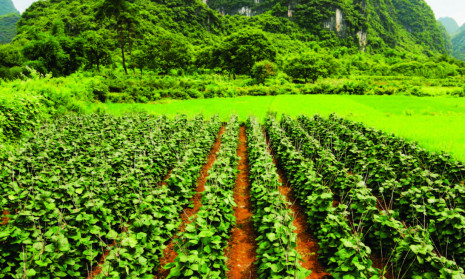Afforestation, food production and poverty- a conflict of interests?

-
Negotiations about the control of climate change have centred on human activities that increase emissions and on strategies that can reduce the amount of greenhouse gases.
The imperatives of raising income and alleviating poverty imply increased economic activity and higher levels of emission. To some degree these can be countered by improved technologies that depend less on fossil fuel and clean up emissions to the atmosphere and water.
However, given rising global populations, the gradual increased proportion, who expect to enjoy the multiplying comforts of modern society, suggests that far from decreasing man-made pressures on climate they will increase.
-
This makes strategies that effectively diminish the level of greenhouse gasses attractive, as growing plants accumulate CO2 and store it.
Trees are especially attractive from this perspective, holding on to CO2 for decades in contrast with annual crops that will be used as food or fuel within a short cycle. International negotiations on climate change have accepted additional tree planting as an offset to additional releases as a result of industrial activity. Such policies attract support from a wide range of stakeholders.
Forests provide a home for wildlife, helping to sustain biodiversity. Forests also provide places for recreation, walking, camping and photography. Forest, in mountainous and hilly areas help in water management, slowing run off and reducing flooding downstream.
-
In this edition the paper by David Frape, draws attention to the dangers of relying on afforestation in temperate regions to reduce the need for other measures to limit the emissions of green house gases.
In practice the diversion of land from farming to forest in the UK, and other temperate regions, may actually increase the rate of global warming. This is in contrast to the tropics where afforestation may play a significant role in reducing the rate of global warming.
-
One implication of this analysis is that the whole world’s population has a profound interest in the development of land use in the tropics. There economic pressures, the imperative of reliving grinding poverty for millions of people, may lead to rapid de-afforestation.
This not only provides food from domestic resources but can enable the countries concerned to derive income from exports and a step along the long process of economic development.
In all our interests we would want to see new forests planted in such poor tropical regions but we cannot expect them to make this choice if it denies them a route to become richer.
It becomes in the interest of temperate, relatively rich countries, to invest in afforestation in the tropics, provide capital and knowhow to encourage a broader based economic growth in low income tropical countries. Such investment may be labelled ‘aid’ but in reality it is a critical step in seeking to protect the wealth and welfare of the rich countries themselves.
-
A second implication relates to the development of land use policy within the temperate countries. Thanks to modern farming methods, the use of pesticides, fertiliser, powered machinery and a sophisticated food industry there is a chronic tendency for over-supply in temperate countries.
As a result, in the absence of government intervention the return on farming is often low and always volatile. Governments have responded through a variety of support mechanisms – many of which have transferred all or part of the costs of uncertainty to the public purse.
The costs can be substantial – as the history of conflict about the cost of the CAP illustrates. Afforestation, especially in remote hill areas seems to offer an attractive way of taking some of the more vulnerable farm businesses out of food production. This is made even more attractive through advocacy by environmental lobbies and the belief that the same action can be given credit for reaching climate change targets.
The evidence provided here challenges that assumption. In addition it may strengthen the case for sustaining land in manner that enables it to be used for food production with low transitional costs but represents a better deal in reducing radiative forcing.

